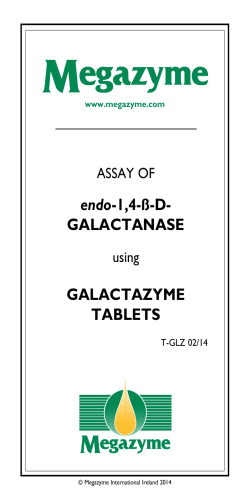
Purity Determination of C -Acetate Using Isotope Ratios Waters
Waters Alliance LC/MS System Purity Determination of C13-Acetate Using Isotope Ratios Brian Walker, Waters Australia, Sydney, Australia Background Key Words Electrospray ionization, ESI Flow injection analysis Isotope ratios Purity ZMD mass detector Z-Spray source The goal of this study was to demonstrate the applicability of mass spectrometric detection to the analysis of isotope ratios to determine purity. The samples were run previously using the Platform LC Mass Spectrometer and the C13-acetate purity result was less than anticipated. The reason for the low purity result was possibly caused by a trace C12 acetate contamination following the use of ammonium acetate buffers. In this study the acetate sample was run on the ZMD4000 Mass Spectrometer which has a much improved interface facilitating easy cleaning access to all components in the source. This allows the removal of contaminants from previous analyses. Flow injection analysis (FIA) was used because isotopic purity was required for one compound. Analytical Conditions Instrumentation: Waters Alliance LC/MS System consisting of 2690 Separations Module and ZMD mass detector. The optimum ionization mode was negative electrospray (ESI) for the best signal-to-noise ratio. However, both positive ESI and atmospheric pressure chemical ionization (APCI) can be used. Sample: C13 sodium acetate was dissolved in 0.1% citric acid. The final concentration was 0.1 mg/mL. Flow injection analysis was done in a mobile phase of 0.1% citric acid at a flow rate of 100 µL/min. AMD 34 2000 Waters Corporation The LC/MS Market Development Group 1 Figure 1: TIC Chromatogram from Flow Injection Analysis of Sodium Acetate C 13 N aAc N A A C S m (M n, 2 x 5 ); S m (M n, 2 x3 ) Scan ES T IC 1 .7 9 e 8 3.94 100 1 0u l F low Injec tio n A n a lys is of C 13 N a A c e ta te 0.1 m g/m l Following optimization of mass spectrometric conditions for negative ion electrospray, samples were injected and the mass spectra were scanned from 50 m/z to 70 m/z. Ions specific to the analyte were extracted from the full scan data. Figure 1 shows the MassLynx total ion current TIC profile from the flow injection analysis of a 10 µL sample. Analysis time to acquire results is about two minutes per sample. % 1 T im e 0 .5 0 1 .0 0 1 .5 0 2 .0 0 2 .5 0 3 .0 0 3 .5 0 4 .0 0 4 .5 0 5 .0 0 5 .5 0 6 .0 0 6 .5 0 7 .0 0 7 .5 0 8 .0 0 Figure 2: Spectrum of C13 Sodium Acetate C13 NaAc NAAC 389 (3.916) Cn (Top,2, Ht); Sm (SG, 2x0.43); Sb (1,30.00 ); Cm (382:402-(327:347+544:568)) 60 100 [M-H]- Scan ES2.39e7 C13Acetate No. 1 2 3 ESI Negative Ions Mass Intensity Acetate Ions C12 C12 H3 O2 59 2.12e5 C12 C13 H3 O2 60 2.39e7 61 3.13e5 C13 C13 H3 O2 The purity of the C13 sodium acetate was found to be 99.13% by the calculation shown on Figure 2. This was possible because of the wide linear dynamic range of the Dynolite detector. Isotope Ratio Calculations 60 + 61 C13 masses 59 + 60 + 61 Total % 239 + 3.13 2.12 + 239 + 3.13 Intensity ratio % Purity = 242.13 x 100 = 99.13% 244.25 59 AMD 34 2000 Waters Corporation The Z-Spray interface of the ZMD mass detector is easy to clean and can reduce the possibility of errors due to source contamination. It can yield good isotope ratio values for highly purified compounds. 62 61 59 0 Spectra were extracted from the apex of the sodium acetate peak and isotope ratios were calculated based on the intensity of the [M-H]- ions 59, 60, 61 and 62 (Figure 2). The mass of C13-acetate is 60 containing one C13 atom. m/z 60 61 62 The LC/MS Market Development Group 2
© Copyright 2026





















